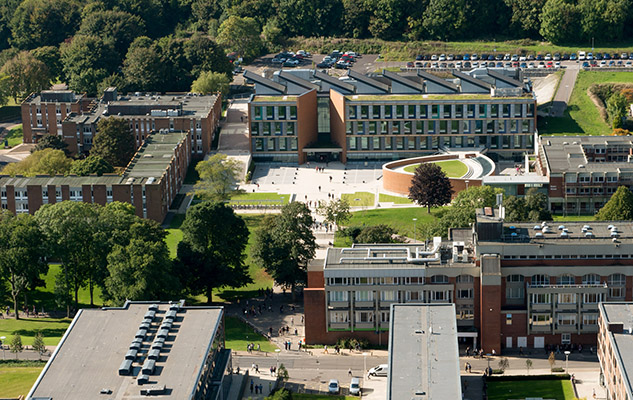Facts and figures
The University of Sussex is a leading higher education and research institution near Brighton, in the south of England. Sussex was the first of the new wave of UK universities founded in the 1960s, receiving its Royal Charter in 1961.

Innovative research and scholarship
Sussex is a leading research university, as reflected in the 2021 Research Excellence Framework (REF 2021).
For REF 2021, 89% of the research we submitted was categorised ‘world-leading’ (40.6%) or ‘internationally excellent’ (48.4%).
Also, 93% of our research impact was assessed to be ‘outstanding’ or ‘very considerable’ – up from 80.7% in 2014.
Find out more about REF 2021 at the University of Sussex.
Teaching and learning
The University of Sussex has 18,510 students (2020-21 full-time equivalent figures), of which around one-fifth are postgraduates. 70% of our student population are UK students and 30% are overseas students.
Creative thinking, diversity in our teaching, intellectual challenge and interdisciplinarity have always been fundamental to a Sussex education.
Our goal is to deliver teaching and learning programmes informed by current research, attractive to students from all socioeconomic and cultural backgrounds and which deliver skills for life.
Our staff
Sussex has developed a reputation for innovation and inspiration, and attracts leading thinkers and researchers.
In 2020/21 the University employed 3,490 staff which is equivalent to 2,555 full time employees. This incorporated 1,755 staff in a Teaching or Teaching and Research role (equivalent to 1,070 full time employees). Other staff were employed in Research only or Professional Services positions (HESA 2020/21).
Five Nobel Prize winners have been members of staff at Sussex. We have also had 12 Fellows of the British Academy and a winner of the prestigious Crafoord Prize on our staff.
International Sussex
From its foundation, Sussex has had an international perspective to its academic activities and its outlook.
We attract staff and students from just over 100 countries to our campus, and over a quarter of staff come from outside the UK.
Our research tackles major world issues with leading areas of expertise such as climate change and development studies.
We have extensive links with institutions worldwide. To get a sense of our partners and the type of partnership work we engage in, please see our Global Engagement pages.
Campus life
Sussex has one of the most beautiful campus locations in the UK.
Situated in rolling parkland on the edge of Brighton, the campus combines award-winning architecture with green open spaces.
The campus is surrounded by the South Downs National Park but just a few minutes away from the lively city of Brighton & Hove.
Designed by Sir Basil Spence, the buildings that make up the heart of the campus were given listed building status in 1993. Falmer House is one of only two educational buildings in the UK to be Grade I-listed in recognition of its exceptional interest.
Business and the community
Sussex has a long tradition of engaging with business and the community, which continues today through activities such as the Sussex Innovation Centre, public lectures and services to the community.
Our goal is to help businesses and organisations in the region develop higher staff skill levels through training, and to stimulate innovation through partnership with other institutions outside Sussex to benefit the wider society.
The Sussex Innovation Centre provides support for the creation and growth of technology- and knowledge-based companies in Sussex.
The Centre is now a thriving business environment for nearly 80 high-growth companies.
Since its creation more than 160 companies have been based at the Centre; their cumulative revenue exceeds £250 million and they employ hundreds of people locally.
Office for Students Transparency information
In accordance with regulations set out by the UK's Office for Students, we publish the following information in the interests of transparency regarding our student body.
The information published on these pages shows:
- The percentage of students who attained a particular degree or other academic award, or a particular level of such an award, on completion of their course with us.
It shows these percentages by reference to:
- The gender of the individuals to which they relate.
- Their ethnicity.
- Their socioeconomic background.
You can download the complete dataset here [XLSL 31KB], which includes the number of students who attained a particular degree or other academic award, or a particular level of such an award, on completion of their course with us.
Percentage of classified first degrees at grade 2:1 or above by characteristic for 2021-22 qualifiers
| Characteristic | Characteristic split | Percentage |
|---|---|---|
| Ethnicity | Ethnic minorities (includes students with Asian, Black, Mixed or other ethnicities) | 83% |
| White | 90% | |
| English Index of Multiple Deprivation (EIMD) 2019 quintile | 1 and 2 | 84% |
| 3 to 5 | 89% | |
| Sex | Female | 91.5% |
| Male | 83.7% | |
| Other | N |
Key:
- EIMD Quintile 1: areas of highest deprivation
- EIMD Quintile 5: areas of lowest deptivation
- N: 20 or fewer students in this population
Access and Participation Plan Monitoring
The impact report summarises the progress made by the University of Sussex against targets, objectives and written commitments as set out in our 2020-21 to 2024-25 Access and Participation Plan. This document is a summary of information submitted by the University to the Office for Students.
See the 2020-21 to 2024-25 Access and Participation Plan Impact Report, [PDF, 791KB]